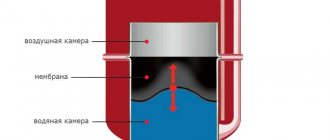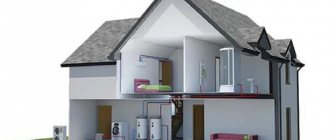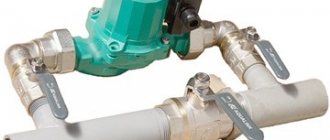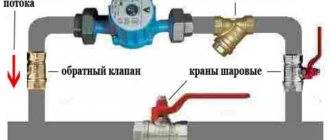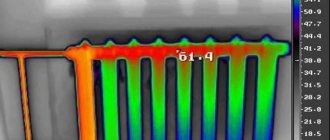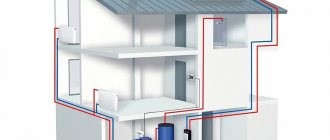For a comfortable life, a modern person needs a basic set of benefits of civilization - electricity, sewerage, water supply and, of course, heating. The latter will be discussed in this article. There are many ways to arrange heating and maintain the optimal temperature in your home; among them, due to its simplicity and accessibility, an open two-pipe heating system stands out. It is worth choosing if you have a limited budget for building a house and laying communications inside it, or if for some reason you do not want to contact third-party specialists, but want to do everything yourself. Are you interested in a DIY open heating system? Then you need to be well prepared for its arrangement and start working by reading this article.
DIY open heating system
Definition of an open heating system
It is well known that a coolant liquid circulates through pipes between the boiler installation and heating devices, acting as an intermediary for the transfer of thermal energy. Unlike furnaces, which heat the air around them directly, a water system can transfer heat over long distances. This led to its widespread implementation. The simplest diagram of an open heating system for a one-story house is shown in the figure:
Water flowing through pipelines expands due to heating. The resulting excess is forced into a special container - an expansion tank. A feature of the open circuit that distinguishes it from other systems is the open tank installed at the highest point. In simple words, the container into which excess hot coolant is displaced is directly connected to the atmosphere.
The circuit operates as follows. As the temperature rises, the volume of water in the network increases, and accordingly, its level in the expansion tank rises. In this case, part of the air from the container is simply displaced into the atmosphere through the pipe. When, for various reasons, the temperature drops, the coolant level in the tank also decreases, and outside air takes its place, freely entering through the open pipe.
Note. The scheme under consideration should not be confused with such a concept as an open heat supply system. The concept refers to centralized networks, from which the coolant is irretrievably withdrawn for the needs of hot water supply. For individual heating of private houses and other buildings, such schemes are not used.
Options for piping in the system
The efficiency, economy and aesthetics of the heat supply system depend on the layout of heating devices and connecting pipes. The choice of wiring is determined based on the design features and area of the house.
Specifics of one-pipe and two-pipe schemes
Heated water flows to the radiators and back to the boiler in different ways. In a single-circuit system, the coolant is supplied through one large-diameter pipeline. The pipeline runs through all radiators.
Advantages of a single-pipe self-circulation system:
- minimal consumption of materials;
- ease of installation;
- limited number of pipes inside the living space.
The main disadvantage of a scheme with one pipe performing supply and return duties is the uneven heating of the heating radiators. The heating intensity and heat transfer of the batteries decreases as they move away from the boiler.
With a long wiring chain and a large number of radiators, the last battery may turn out to be completely ineffective. “Hot” heating devices are recommended to be installed in north-facing rooms, children’s rooms and bedrooms
The two-pipe heating scheme is confidently gaining ground. Radiators connect the return and supply pipelines. Local rings form between the batteries and the heat source.
Main advantages of the system:
- all heating devices heat up evenly;
- the ability to adjust the heating of each radiator separately;
- reliability of operation of the circuit.
A dual-circuit system requires large investments and labor costs. It will be more difficult to install two lines of communications along building structures.
The two-pipe system is easily balanced, ensuring the supply of coolant at the same temperature to all heating devices. Rooms are heated evenly
Upper and lower coolant supply
Depending on the location of the main line supplying hot coolant, a distinction is made between upper and lower connections.
In open heating systems with overhead wiring, there is no need to use air exhaust devices. Its excess is discharged through the surface of the expansion tank communicating with the atmosphere (+)
With overhead distribution, warm water rises through the main riser and is transferred through distribution pipelines to the radiators. The installation of such a heating system is advisable in one- and two-story cottages and private houses.
A heat supply system with bottom wiring is quite practical. The supply pipe is located at the bottom, next to the return pipe. Coolant movement in the direction from bottom to top. The water, having passed through the radiators, is directed through the return pipeline to the heating boiler. The batteries are equipped with Mayevsky valves to remove air from the line.
In heating systems with bottom wiring, it becomes necessary to use air exhaust devices, the simplest of which is the Mayevsky tap
Vertical and horizontal risers
Based on the type of position of the main risers, a distinction is made between vertical and horizontal pipeline routing methods. In the first option, radiators on all floors are connected to vertical risers.
Vertical wiring is used when arranging houses with two, three or more floors with an attic space, within which a pipeline can be laid and insulated (+)
Features of “vertical” systems:
- no air pockets;
- suitable for heating high-rise buildings;
- floor connection to the riser;
- difficulties in installing apartment heat meters in multi-storey buildings.
Horizontal wiring involves connecting radiators on one floor to a single riser. The advantage of the scheme is that the device uses fewer pipes and installation costs are lower.
Horizontal risers are usually used in one- and two-story premises. The arrangement of the system is relevant in panel-frame houses and residential buildings without walls
Types of open systems
Such water heating schemes are divided into types depending on the method of circulation and delivery of coolant to the radiators and its subsequent return back to the boiler. Heated water can move through pipelines in two ways:
- using natural circulation;
- artificial stimulation from the pump.
Due to the design features, there is practically no excess pressure in an open heating system. At the highest point it is equal to atmospheric pressure, and at the lowest it increases slightly due to the hydrostatic effect of the water column. The value of this pressure is small, which makes it possible to organize natural circulation of the coolant. The principle is based on the fact that coolant with different temperatures has different densities, and therefore mass. Example: 1 m3 of water at t = 40 °C weighs 992 kg; after the temperature rises to 60 °C, the mass of 1 m3 drops to 983 kg.
It would seem that the difference is insignificant. Nevertheless, it allows the cooled coolant at a low temperature to displace lighter hot water from the boiler. Natural (convective) circulation occurs in pipelines, and such systems are called gravity or gravitational, because movement in them occurs due to gravity. Therefore, the coolant flow rate in the mains and radiators is low, only 0.1–0.3 m/s. But such schemes are completely energy independent, provided that boilers for an open heating system that do not require electricity work together with them.
Note. In gravity systems, lines are made with increased slopes and pipe diameters.
In order to increase the speed of water flow through the pipes and reduce the heating time of the premises, a pump is built into the main line coming from the boiler. It forces the coolant to move at a speed of 0.3-0.7 m/s, which is why heat transfer occurs more intensely and all branches heat up more evenly. Thanks to the presence of a pump, the distance between the heat source and the batteries can be increased both in length and height.
Installing a pump unit allows you to create a slight excess pressure in the heating system, allowing the coolant to flow well into the radiators. This definitely increases the efficiency of the system as a whole, although it makes it dependent on the availability of electricity.
Note. To ensure that the heating of a private house does not stop when the electricity is cut off, it is customary to install the circulation pump on a parallel bypass line.
Closed heating system
The main difference between a closed heating system is the use of a circulation pump, which moves the coolant. Otherwise, the operating principle is the same as in an open system. In a closed pipe system, radiators heat up much faster.
Recommendations for use
The membrane-type tank is sealed, which prevents evaporation of the coolant. This means that antifreeze can be used. Its use makes it possible to leave your home for a long time in winter: the risk of freezing and damage to the system is reduced to almost zero.
Installation recommendations
To ensure proper functioning of a closed heating system, we recommend adhering to the following tips:
- The expansion tank is installed directly indoors. At the same time, the costs of pipeline elements are reduced and the coolant does not freeze.
- Using pipes of smaller diameter does not mean that you need to install pipes with a minimum cross-section. This method of saving money can have a destructive effect on the entire heating system. There is a risk of increasing pressure in the pipeline, and the pump may not be able to cope with this.
- Particular attention must be paid to the correct installation of the pump. The rotor is located horizontally relative to its own axis. This contributes to silent operation and less friction with the coolant.
- The circulation pump and expansion tank are installed in front of the boiler entrance.
Advantages/disadvantages of a closed system
The main advantages of a closed system are:
- Easy to install the system.
- Lower cost of heating structure. This is achieved due to the possibility of using pipes with a smaller diameter.
- There is no need to control the coolant level. The tightness of the expansion tank does not allow the coolant to evaporate.
- Ability to regulate temperature. This occurs when the amount of coolant supplied increases/decreases.
- Possibility of floor heating. A special additional element is connected to the heating system.
A closed heating system has one significant drawback. The system depends on the electrical supply. Constant power consumption must be ensured. You will have to purchase backup power supplies in case of an emergency. The best option is liquid fuel power plants.
Types of schemes
Water heated by the boiler can be delivered to the radiators and returned to the boiler in different ways. According to the supply methods, an open heating system with a pump is:
- single-pipe;
- two-pipe.
In a single-pipe system, the coolant supply is organized through one large-diameter pipeline passing past all radiators. The devices are connected to it with both pipes, taking water from the pipe and returning it there. The distribution main can run horizontally within the 1st floor (“Leningradka”), as shown in the diagram:
The system can be in the form of vertical risers that penetrate several floors, and the batteries are connected to them floor by floor. A typical single-pipe heating scheme with forced circulation with vertical risers for a two-story house is shown in the figure:
Along with the apparent simplicity of the design of such schemes, single-pipe systems have a significant drawback: increasingly colder water flows into each subsequent device. This imposes a limit on the number of batteries; for effective heating, their number should not exceed 5. Another thing is a two-pipe system, where the coolant comes to the radiators through one line and leaves through another. In this case, the length of the branches and the number of batteries on each of them can be significantly greater.
In addition, the movement of the coolant can be organized in one direction so that it passes the same distance through all radiators. Such a passing system with a circulation pump is shown in the figure:
The two-pipe system makes it possible to deliver water at the same temperature to all, even the most distant batteries. The circuit is a little more complicated to install, but easier to develop and more reliable to operate.
System installation features
To decide whether to use open heating with or without a pump, you need to take into account the total heated area, the number of floors of the building and the height of the premises, and also determine the thermal operating conditions.
Forced circulation
For better coolant circulation, a pump is installed in open circuits. The device is fixed to the return pipeline before entering the boiler. It is better to install the unit at a distance of 1.5 m from the boiler.
Also pay attention to the following important points:
- Pumping equipment must be mounted on the bypass. This will ensure natural circulation of water when the pump is turned off or breaks down.
- A check valve must be installed. This is necessary to protect against reverse circulation of liquid.
- When installing the pump, take into account the direction of the coolant flow.
Important! Open-type systems with a pump have less inertia, which contributes to faster heating of radiators.
Gravity diagram
In such circuits there are completely no devices that promote forced fluid flow. The movement of the coolant occurs due to the expansion of heated water. For proper operation of such a circuit, an accelerating riser is needed. It is installed vertically after the boiler. The height of this riser must be at least 350 cm.
In addition, when designing circuits with natural circulation, other important factors are taken into account:
- The supply line must necessarily have a slope towards the heating radiators, and the outlet line must have a slope towards the boiler.
- The boiler is installed at the lowest point.
- Be sure to install an expansion tank in the attic.
Advantages and disadvantages
The open heating system has not yet lost its relevance, and recently it has even experienced a rebirth, and there are reasons for this. Many homeowners are concerned about the energy independence of their communications, and the open tank scheme allows this to be achieved. She has other advantages:
- Filling an open heating system and bleeding air is easier than in a closed one. There is no need to monitor the maximum pressure, and when filling, the air leaves the pipelines very quickly through the open expansion tank. All that remains is to ventilate the radiators;
- it’s easier to refill: again, pressure control is not required, and water can be added to the container even with a bucket;
- the operation of the system does not depend on the presence of leaks: here the operating pressure is very low, so as long as there is water in the heating network, it will function properly.
As usual, there were some drawbacks, due to which such systems began to be gradually replaced by closed-type circuits with a membrane expansion tank. Due to the direct contact of the coolant with atmospheric air, two processes occur in the container at once: natural evaporation of hot water and its saturation with oxygen. This leads to the following requirements:
- you need to monitor the water level in the tank and replenish it on time;
- Do not fill the heating network with antifreeze, which releases harmful substances when evaporated.
Oxygen saturation of the coolant leads to a decrease in the service life of steel parts of the boiler. For the above reasons, the open system has not been used in apartment buildings for a long time, although in the 60-70s of the Soviet era such practice took place in low-rise residential buildings. It is also undesirable to operate it with high-temperature heat sources when the coolant is close to the boiling point. The fact is that with increased pressure in a closed network, this threshold increases, and there is nowhere for water to evaporate. In an open system, the amount of water will quickly decrease, freeing up the entire volume of the expansion tank for air.
Selection of components
- Boiler. The ideal place to install the boiler is a separate room, spacious enough (for ease of maintenance) and with access to fresh air. The floor covering should be made of fire-resistant material, such as concrete. By calculating the area of the house, you can determine the required boiler power. It can run on coal, gas, wood, diesel fuel.
The boiler should be located in a separate spacious room
- Radiators. Types of radiators: steel, bimetallic, cast iron, aluminum. The most popular are steel ones. They should be mounted at a distance of 3-5 cm from the wall, no less. The traditional installation location is under the window so that they serve as a barrier to cold air from the street. The most convenient height is 40-60 cm, so that there are gaps: from above to the window, from below to the floor. The length can be any, depending on the area of the room. For example, for a bedroom of 15 m², a radiator 100 cm long is sufficient.
- Pipes. Copper pipes are relatively expensive, steel pipes become rusty over time, so almost everyone chooses plastic pipes. Diameter – 25 mm, 32 mm. The number of pipes depends on the type of system - single-pipe or two-pipe. As a rule, they are not built into the wall, but are carried out in an open way - directly above the floor. The pipes are cut into sections convenient for installation and connected to the boiler, expansion tank and radiators using bends.
- Expansion tank. Its location is in the attic or near the boiler. You should remember how the volume of the tank relates to the size of the system as a whole: it should not be less than 5% of the volume of the entire system. For a one-story private house, you need a tank of at least 8 liters, but it is better to purchase it with a reserve of 15 liters.
You can read about the choice of pipes for installing a heating system, their types and characteristics in our next article:.
